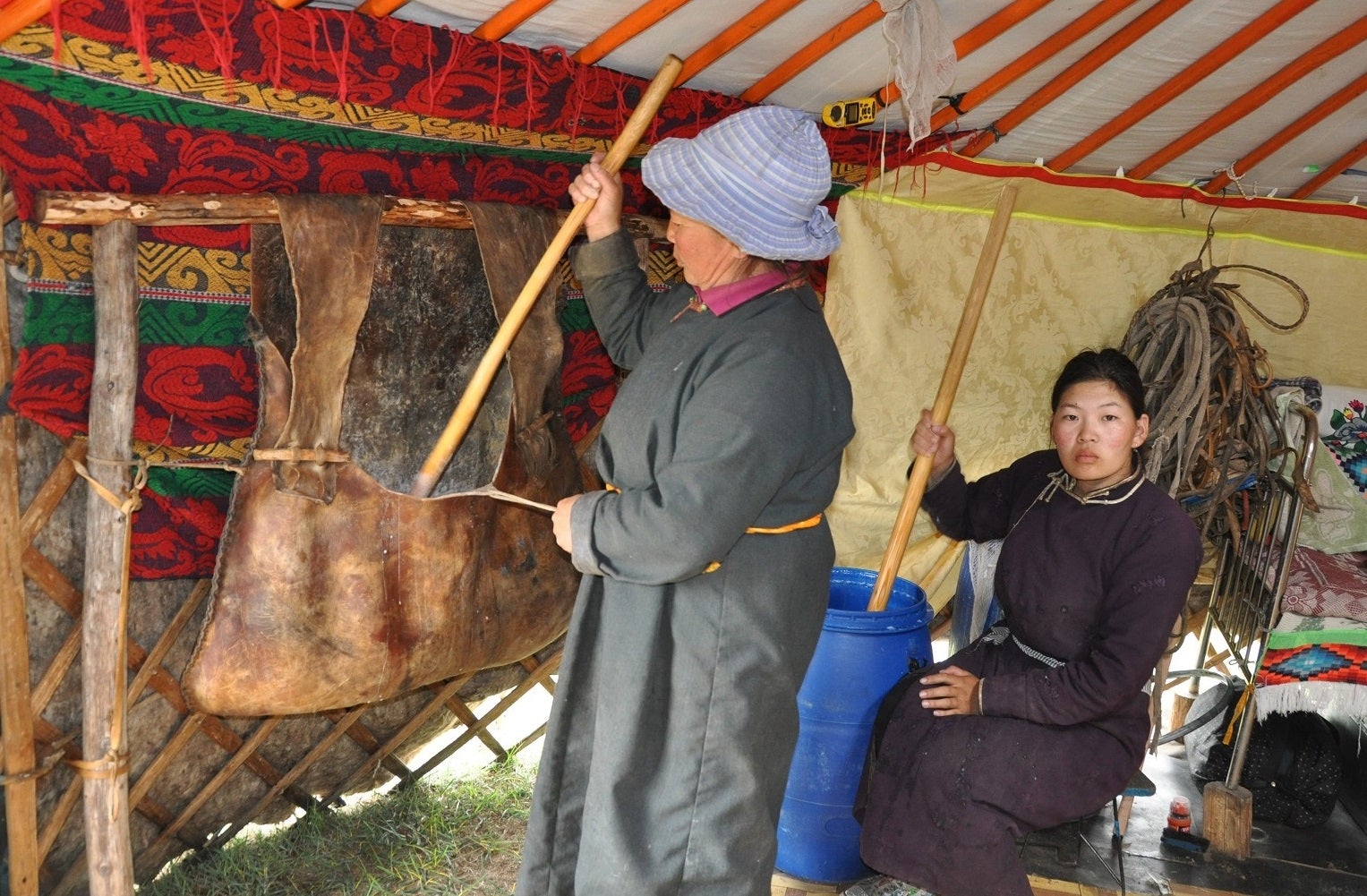
Posted on 02/06/2023 2:00:19 PM PST by nickcarraway
A drink made of fermented horse milk is a staple in the diet of Mongolian herders. Researchers are uncovering the science of its production to better preserve this tradition.
This article was produced for Meiji University by Scientific American Custom Media, a division separate from the magazine's board of editors.
Nomadic life in Mongolia may offer inspiration as societies around the world strive to live more sustainably. Rather than drastically modifying the land for crops or pasture, herders move with their livestock seasonally to utilize natural grasslands that aren’t suitable for agriculture. “They don’t directly own the land, so a broader sense of environmental stewardship has been cultivated,” explains Yuki Morinaga, a climatologist from Meiji University in Tokyo, Japan.
The documentation of traditional and alternative ways of living can provide clues to a more sustainable future, she says. She adds that experienced nomads, for example, know the characteristics of the land and climate so well that they can get through weather below minus 40°C with little fuel.
Globally, more than 70% of dairy products are made from cow’s milk, and cows contribute to a significant proportion of the world’s greenhouse gases when methane is released through digestive processes. However, herders — especially in central Mongolia — consume large quantities of mares’ milk, which is one key source of their nutrition. “The environmental impact of Mongolian horses, and the indigenous method of rearing them is significantly lower than that of cows,” says Morinaga.
Morinaga’s research focus is on the production of a traditional drink called ‘airag’. This slightly alcoholic, fermented beverage made from horse milk is drunk very widely in summer, when mares are lactating. Traditionally, herders have consumed more dairy products in summer and meat products in winter for sustenance, though diets are changing in recent years, Morinaga explains.
Research on horse milk has shown it has relatively high levels of the protein albumin, which can help regulate blood pressure and can also have antimicrobial and anti-inflammatory effects1. Morinaga’s team is currently investigating airag’s probiotic properties.
CULTURAL HERITAGE
There had been little previous research on the production of airag, partly because the process has been passed down orally through generations of herding communities, says Morinaga. In 2019, the traditional method was added to UNESCO’s World Intangible Cultural Heritage list.
Morinaga has since conducted a nationwide survey on airag production in Mongolia, tracked the movement of mares via GPS, and studied the chemical content of the drink. Her work began after Mongolia was hit hard, first by drought and then a heavy snow season, which caused mass livestock deaths (see 'Predicting deadly cold snaps'). Upon learning of the disaster from news reports, Morinaga flew there in 2003. “I thought my expertise could be useful to mitigate the damage of future natural disasters,” she says. She harnessed her contacts at Mongolia’s Information and Research Institute of Meteorology, Hydrology and Environment (IRIMHE) in Ulaanbaatar, and began a two-year project.
Morinaga began studying Mongolia’s climate in Bulgan Prefecture in the north, a region famous for airag, and rapidly became fascinated with the cottage industry. “From the morning to the evening in summer, the herders kept milking, and stirring airag for hours with a stick while drinking with family and friends. After leaving it overnight, the silky, runny, sourish yogurt-like drink is ready,” she says. “They repeat the process day after day. I was very impressed by witnessing seven people in one household make five tonnes of airag from 25 pairs of mares and foals in one summer, using tools that have a low environmental impact.”
Morinaga’s nationwide survey in 2012 identified the regional distribution of airag production and explored the environmental and human factors that determine activity levels2.
AT THE TIME
“At first, it was difficult to get the institute to accept airag as a research subject because it was so ordinary to them,” Morinaga explains. “But since the fermentation of airag and environmental conditions for horse health are linked to climate, they understood that production is probably innately linked to the country’s weather conditions.”
The IRIMHE then asked its agro-meteorologists in 21 provinces to send questionnaires to their stations across 329 counties. In-person interviews were then collected with the help of local herders. Meteorologists collected answers via phone or the Internet. “It was a time-consuming process, but our experience talking to Mongolian people for climate-related fieldwork really paid off,” she says.
Her team gathered more than 2,000 responses and the outcome supported their hypothesis that herders at the centre of the country, where grasslands are abundant and the density of horses is high, are more active in airag production, while those in the east are less active.
The team has also found eastern regions have a large horse population, but airag production is less active — possibly because the horses are bred as racehorses and mares are used primarily to raise foals. “We were able to see quantitatively and clearly that there are regional differences,” says Morinaga.
In 2013, her team also looked at patterns of mare grazing intensity3 and foal interaction. They documented how yurt movement by herders helps to avoid overgrazing pastures, with horses covering roughly 10km2 across the year. The team also documented how mares and foals used to make airag are slowly separated across a three-month period; in contrast to the almost immediate removal of dairy calves from their mothers. The hope, says Morinaga, is that these observations can help inform attempts at more humane practices.
Seeking answers as to why the taste of airag varies, in 2016 Morinaga also organized a contest and collected samples from 51 households, asking a team of tasters to score them4.
The samples that scored well all had lower levels of electric conductivity, which corresponds to acidity, and so Morinaga and her team have suggested that electric conductivity could be employed as a method for measuring and controlling the quality of the dairy product.
“Through my research, I have come to realize this tradition is not something to be exhibited in a museum,” says Morinaga. “It is something that is very woven into people’s lives and uniquely customized to the landscape, and those are things we need to think about to really live sustainably.”
In a ger, a Mongolian nomad dwelling, a mother and daughter stir airag. The mother uses a traditional cowhide huhuur and the daughter a plastic bucket. The family and other community members will take turns at stirring for several hours. References
1. Chen, Y. et al. Journal of Dary Science (2010) doi: 10.3168/jds.2009-2672
2. Bat-Oyun, T. et al. Nomadic Peoples (2015) doi: 10.3197/np.2015.190103
3. Bat-Oyun, T. et al. Animal Science Journal (2018) doi: 10.1111/asj.12842
4. Tsuchiya, R. et al. Foods (2020) doi: 10.3390/foods9030333
5. Nandintsetseg, B. et al. Developing an early warning system of dzud (cold-season disaster) in Mongolia. Technical Report for the International Federationof Red Cross and Red Crescent Societies (2019) doi: 10.13140/RG.2.2.33661.72161
Nomadic life in Mongolia, where herders utilize natural grasslands that aren’t suitable for agriculture, may offer examples of ways to live more sustainably. In 1987 Yuki Morinaga became the first female scientist to travel with a Japanese research expedition to Antarctica, where she investigated the interaction between snow and the atmosphere, and installed weather observation stations in remote inland areas. Her work on the interaction between snow and ice has also taken place in the harsh environments of Japan's Northern Alps, the Himalayas and Tibet.
In 2003, Morinaga was funded by Meiji University’s overseas research programme to investigate a type of natural disaster Mongolians call dzud – cold season weather leading to a mass death of livestock.
Mongolia’s grasslands, or steppes, faced a particularly harsh series of dzuds between 1999 and 2002. At the time, Mongolia’s zoo-meteorological data collection, which is done by herders themselves as they move, was too incomplete to help mitigate the disasters. To address the situation, and with Japanese government funding, Morinaga’s team reviewed observation manuals, renewed equipment and provided technical guidance.
In collaboration with the Information and Research Institute of Meteorology, Hydrology and Environment (IRIMHE) of Mongolia, researchers from Japanese universities have now developed an early warning system to forecast the impact of pending dzuds. Since 2015, IRIMHE has published an annual risk map, which is distributed to the public5.

It’s a wireless smart home
(above her head)
Very interesting, helping the locals with information, but throwing in the man made climate change hoax?
Maybe it was the only way she could get funding.
Also, I don’t know what she is making in that leather pouch, but that is mold growing on the leather.
Yum. I have fermented cow’s milk, AKA yogurt, every night for dessert. Plain yogurt with some kind of fruit, blueberries and strawberries taste best.
I do sleep well and never miss things like ice cream. Sugar can keep you awake.
Yes, we Khan! Yes, we Khan!
Obviously, they want us to switch to horse milk.
Then the horse meet will follow!
Try whole milk yogurt with a small amount of natural honey.
Shed Your Hi-Tech lifestyle and take up the Nomad life now.
Show the world how everyone can move to a SUSTAINABLE (Lord they love that word) lifestyle by doing it right now!
Yuki is yet another one riding the "Climate Change/Sustainable Future" gravy train, but doesn't want to walk the walk.
Besides, the Mongolian nomadic, ‘sustainable’ lifestyle has contributed sooooo much to the human race. All the modern methods that have increased life expectancy, modern health care, etc. /s
Horse kefir?

However, Dannon is among the worst yogurts you can eat due to all the added sugar (to make it "low fat").
Siggi's triple cream low fat yogurt is my go-to.

“They don’t directly own the land”
“yurt movement by herders helps to avoid overgrazing pastures”
“customized to the landscape, and those are things we need to think about to really live sustainably”
“offer examples of ways to live more sustainably”
Careful trying to make one cultures ways a one size fits all or it starts to look like Lenin, Mao or Pol Pot evil.
Sustainable is often a costume for communism. Yep, it just hasn’t been done right.
Good luck finding a yoghurt that doesn’t have a ton of sugar.
I had fermented camel milk in Kazakhstan. Tasted like yogurt.
Found one.

Disclaimer: Opinions posted on Free Republic are those of the individual posters and do not necessarily represent the opinion of Free Republic or its management. All materials posted herein are protected by copyright law and the exemption for fair use of copyrighted works.